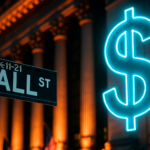The warning signals are loud and clear as major U.S. retailers project uncertainty over the upcoming holiday shopping season. Recent financial analyses underscore the growing caution among consumers, influenced considerably by ongoing geopolitical factors like tariffs. These factors have draped an air of uncertainty over consumer sentiment, now mirrored by erratic spending patterns observed across sectors renowned for discretionary spending. The market remains tense and focused on how these economic headwinds will affect key retail players in the months ahead.
Retailers have previously encountered similar challenges, prompting strategic shifts to mitigate risks. Historical strategies involved tightening inventory levels and diversifying product portfolios to buffer shifts in consumer behavior. Current indicators, however, suggest a protracted slowdown with potential for deeper market impacts, far different and perhaps more pervasive than previous downturns. This cautious market environment continues to necessitate vigilant observation and adaptive strategies by retail giants.
What Are Major Retailers Saying?
Several retailers have given stark outlooks for the near term. Target, for instance, has indicated its serious approach in addressing these uncertainties.
Target’s Chief Commercial Officer Rick Gomez mentioned, “We are planning cautiously for the back half of the year.”
Home Depot’s forecasts were kept constant, although its quarterly results disappointed investors. Home Depot’s issues align with sector-wide headwinds notably in the home and garden markets.
Why Is Consumer Spending Decreasing?
Analysts see a blend of high interest rates and housing market stagnation as primary forces nudging consumers to hold back on discretionary spending. Lowe’s, echoing sentiments similar to those at Home Depot, anticipates ongoing challenges due to elevated mortgage rates and subsequent consumer caution. The situation paints a scenario where larger market players may capitalize on their stronger pricing strategies to outperform smaller competitors.
Also showing signs of distress, the restaurant industry has reported similar declines as consumers opt to dine less frequently outside their homes. Brands like IHOP, Applebee’s, and Wendy’s are noticing decreased sales, attributed partly to rising economic pressure on household spending. Fast-food giant McDonald’s pointed out specific declines in visits by low-income customers though overall sales managed a recovery last quarter.
“The result of that is you’re seeing people either skip occasions,” McDonald’s CEO Chris Kempczinski added, referring to significant menu downgrades as economic pressures mount.
Emerging trends hence reveal a decided pullback in consumer spending, worsened by fiscal uncertainties and regional economic factors. The strategic responses by retailers and consumer brands could modulate the market’s ultimate performance through upcoming shopping periods.
This slow spend momentum serves as a reminder of the dynamic challenges within retail sectors requiring adaptive measures. Continuing shifts in consumer behavior, along with broader economic influences, demand strategic vigilance from retail leaders. Effective navigation may well emerge from targeted investments and consumer-specific adaptations capable of withstanding economic shifts more adeptly. Retailers might need to redefine operational resilience, grasping nuanced market needs to capitalize on emerging opportunities.










